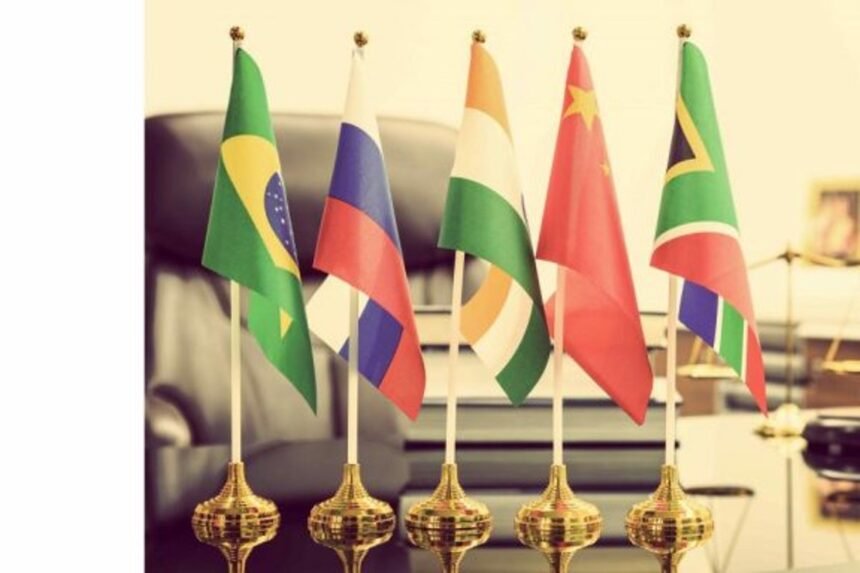As global markets evolve, the BRICS countries — Brazil, Russia, India, China and South Africa — emerge as economic opportunity powerhouses. Offering a blend of rich natural resources, expanding middle classes and technological innovation, these nations are on the radar of savvy investors. But investing in BRICS isn’t as simple as hitting buy on your trading app.
Trading in BRICS countries involves navigating unique market conditions, risks and regulatory landscapes, as well as understanding the different instruments and tools available to you as an investor. Here’s all you need to know about the BRICS countries, the different ways you can invest in them and some potential risks to be aware of.
What is BRICS?
BRICS is an acronym that stands for Brazil, Russia, India, China and South Africa — five major emerging economies that have garnered significant attention for their prominent roles in the global market and political sphere.
Unlike traditional economic unions like the European Union or military alliances like NATO, BRICS is not a formal trading bloc with a single currency or a unified political system. Instead, it is a loose, informal alliance aimed at fostering mutual benefit through economic cooperation, trade partnerships and diplomatic dialogues.
The five countries meet annually at the BRICS Summit to discuss various issues from economic policies to regional security, and they have also formed sub-committees and working groups to collaborate on specific sectors such as finance, technology and healthcare.
In 2024, the group expanded to include four member countries: Iran, Egypt, Ethiopia, and the United Arab Emirates.
History of BRICS
BRICS is an acronym that originally began as BRIC in 2001, coined by Jim O’Neill, a Goldman Sachs economist, to represent Brazil, China, India, and Russia. In 2010, South Africa joined the group, expanding it to BRICS.
The idea of BRICS was initially set into motion by Russian President Vladimir Putin, who called the first BRICS Ministerial Meeting on Sept. 20, 2006. This meeting, held on the sidelines of a UN General Assembly Session, involved the foreign ministers of Russia, Brazil and China, as well as the Indian Defense Minister.
Building on this initial meeting, a second gathering took place on May 16, 2008, in Yekaterinburg, Russia. Yet another milestone was reached later that year when the leaders of these emerging economies met at the G8 Summit in Toyako, Japan.
The formal inception of BRIC (before the inclusion of South Africa) came in June 2009 with the first BRIC Summit and the issuance of a joint statement that laid out the coalition’s objectives. Since then, the coalition has met annually during their summits to work on action plans.
BRICS GDP and Growth Rates
| Country | GDP in US Dollars (2022) | GDP Growth Rate (2022) |
| Brazil | $1.9 trillion | 2.9% |
| Russia | $2.2 trillion | -2.1% |
| India | $3.4 trillion | 7.2% |
| China | $18 trillion | 3.0% |
| South Africa | $405.3 billion | 1.9% |
| Saudi Arabia | $1.1 trillion | 8.70% |
| United Arab Emirates | $507.1 billion | 7.90% |
| Egypt | $476.8 billion | 6.60% |
| Iran | $413.5 billion | 3.80% |
Source: World Bank Data as of 2022
The GDP and growth rate data for the BRICS nations and their newly added members provide valuable insights for investors looking to enter these emerging markets.
Brazil
Brazil’s GDP was $1.9 trillion, and its growth rate was 2.9%. Due to its strong agricultural and mineral resources, Brazil offers investment opportunities in agribusiness, renewable energy, and infrastructure projects.
Russia
Despite recent economic downturns caused by sanctions and geopolitical tensions, Russia remains a key player in the energy sector, especially oil and gas. It has a GDP of $2.2 trillion, though its growth rate in 2022 was negative at -2.1%.
India
India has the highest growth rate, 7.2%, and a GDP of $3.4 trillion. Its booming tech industry and strong consumer market present vast opportunities in technology, pharmaceuticals, and renewable energy.
China
China, the largest economy in the group, has a GDP of $18 trillion and a growth rate of 3.0%. It offers extensive investment prospects in manufacturing, technology, and consumer goods sectors, supported by its growing middle class and rapid urbanization.
South Africa
With a GDP of $405.3 billion and a growth rate of 1.9%, South Africa has a diverse economy, especially in mining, finance, and manufacturing. It offers attractive investment opportunities as a strategic gateway to broader African markets.
New Members
Saudi Arabia
Saudi Arabia, a new member, has a GDP of $1.1 trillion and an impressive growth rate of 8.7%. Under Vision 2030, it is diversifying its economy, creating exciting opportunities in tourism, entertainment, and non-oil industries.
United Arab Emirates
With a GDP of $507.1 billion and a growth rate of 7.9%, the United Arab Emirates serves as a major business hub, with significant investments in real estate, tourism, financial services, technology, and renewable energy.
Egypt
Egypt, undergoing economic reforms and infrastructural investments, has a GDP of $476.8 billion and a growth rate of 6.6%. It offers promising prospects in construction, natural gas, and tourism.
Iran
Despite sanctions, Iran has shown economic resilience with a GDP of $413.5 billion and a growth rate of 3.8%. It offers opportunities in the energy, agriculture, and automotive sectors. Potential investors in Iran should closely monitor geopolitical developments.
Should You Invest in BRICS Currency?
Investing in the currencies of the BRICS countries can offer a unique set of opportunities and risks, often distinct from those associated with investing in more developed markets. Here’s a look at some of the main benefits and drawbacks.
Benefits
- Diversification: Investing in BRICS currencies can be a good way to diversify your portfolio, especially if you’re heavily invested in Western currencies like the U.S. dollar or the euro.
- Currency appreciation: As these economies grow, their currencies may appreciate relative to other major currencies. This factor could significantly boost your returns when you convert your investment back to your home currency.
- Trade opportunities: As the economic influence of the BRICS nations grows, their currencies could become more relevant in international trade, thereby creating a demand that could enhance their value.
Drawbacks
- Inflation: Some BRICS countries, like Brazil and Russia, have experienced periods of high inflation, which can erode the real value of investments.
- Geopolitical risks: Global events, like sanctions on Russia or trade wars involving China, can lead to sharp declines in the value of a country’s currency.
- Currency controls: Some BRICS nations have strict capital controls, making it challenging to move money in and out of the country. For example, China’s tightly managed currency exchange system poses such a risk.
10 Top Ways to Invest in BRICS
Buying foreign currency isn’t the only way to invest in BRICS. Investors have access to a variety of other traditional and non-traditional investment vehicles. Here are the top 10 ways to invest in BRICS, offering a variety of approaches to suit different risk appetites and investment goals.
ETFs
Investing in BRICS countries via exchange-traded funds (ETFs) is a straightforward process. These funds trade on stock exchanges like individual stocks and often track a specific index, which can be focused on one BRICS country or the entire group. By buying shares of an ETF, investors get exposure to multiple stocks within that index, providing a level of diversification and mitigating risk.
However, it’s essential to consider factors like expense ratios, which can erode returns, and liquidity to ensure easy buying and selling. There’s also a need to be aware of currency risks and the volatility often associated with emerging markets.
Popular examples of ETFs for investing in BRICS include the iShares MSCI Brazil ETF (NYSEARCA: EWZ), the iShares MSCI India ETF (NYSEARCA: INDA), the iShares MSCI China ETF (NYSEARCA: MCHI) and the iShares MSCI South Africa ETF (NYSEARCA: EZA). There’s also the iShares MSCI BIC ETF (NYSEARCA: BKF) which holds Brazilian, Indian and Chinese stocks.
Mutual Funds
Investing in BRICS through mutual funds offers another way to gain exposure to these emerging markets. Managed by professional portfolio managers, these funds pool money from multiple investors to buy a diversified set of assets like stocks or bonds from BRICS countries. Investors can buy shares of the mutual fund, and in return, they own a portion of its portfolio.
Unlike ETFs, mutual funds are not traded on an exchange and their prices are determined once a day after market close, with investors buying at that price. In addition, they often come with higher fees compared to ETFs and may require a minimum investment amount, which varies from fund to fund.
Like all investments in emerging markets, BRICS-focused mutual funds come with risks like currency fluctuations, economic volatility and political uncertainty.
Emerging Markets Funds
Emerging markets funds can be ETFs or mutual funds that aim to offer investors exposure to a broad range of emerging markets, not just the BRICS countries. These funds often track external benchmark indices, like the MSCI Emerging Markets Index or the FTSE Emerging Index, to guide their investment strategies.
While they do include assets from BRICS nations, their scope is much wider and may encompass other emerging or frontier markets like Vietnam, Mexico, Indonesia or Turkey, potentially offering greater diversification. However, the broad focus means your investment in BRICS will be diluted by assets from other countries.
Stock Market Investments
Investing directly in the stock markets of BRICS nations involves buying shares of individual companies. This strategy allows investors to target specific sectors or businesses but also comes with heightened company-specific risks. Additionally, not all brokerage platforms offer the ability to trade foreign stocks, and you may need to convert your currency to make a purchase, adding to the cost.
Currency Markets
Investing in BRICS currencies can be done through forex trading or using currency futures. While this method provides a way to benefit from currency appreciation, it’s also fraught with risk. Forex markets are highly volatile and require a deep understanding of macroeconomic factors. Currency futures are complex financial instruments that might not be suitable for all investors.
Real Estate Investment Trusts (REITs)
REITs in BRICS countries provide an indirect way to invest in real estate markets. These trusts invest in property and allow individual investors to buy shares in these properties. However, this investment type comes with its set of risks, such as instability in China’s real estate market or unfavorable taxation laws in some BRICS nations.
ADRs and GDRs
American Depository Receipts (ADRs) and Global Depository Receipts (GDRs) represent shares in foreign companies and are traded on U.S. and international exchanges, respectively. These instruments allow investors to avoid the complexities of currency conversion but still come with the inherent risks of investing in individual companies.
Private Equity and Venture Capital
These investments are usually only open to high-net-worth or institutional investors and involve directly investing in private companies or startups in BRICS nations. This approach has the potential for high returns but also carries a high level of risk and illiquidity and requires a long investment horizon.
Bonds and Fixed-Income Securities
Investing in bonds from BRICS involves purchasing debt securities either from their governments or companies. While generally considered less volatile than stocks, these investments can carry credit risks and may be illiquid. Pricing them can also be a challenge because of data limitations and market inefficiencies.
Infrastructure Projects
Investing in infrastructure involves financing large-scale projects like roads, bridges and airports, usually through a public-private partnership. This investment has a long-time horizon and carries risks like project delays and cost overruns. However, it can provide stable, long-term returns. Like private equity and venture capital, it may not be available to retail investors.
A New World Order to Invest In?
BRICS nations represent a burgeoning frontier for global investment, often seen as an alternative or supplement to more established markets. As the global geopolitical landscape changes, these countries could be poised for dominance.
The investment landscape in these countries is diverse, offering a plethora of options from direct stock purchases and currency trading to more complex and indirect vehicles like ETFs, mutual funds and infrastructure projects.
Each method comes with its unique set of rewards and challenges, from the high-return, high-risk world of private equity and venture capital to the more stable but still volatile arena of bonds and REITs.
Given the array of investment opportunities and the risks of each, due diligence and a well-rounded understanding of the individual countries and their broader economic context are crucial for anyone looking to invest in BRICS.
Frequently Asked Questions
A
BRICS has had mixed success; while it has created platforms for economic collaboration and increased its members’ global influence, challenges like economic disparity and political differences among the nations remain.
A
BRICS aims to provide a collaborative, cooperative coalition for emerging economies when it comes to global governance and economic issues, focusing on mutual growth, security and development.
A
The BRICS bank, formally known as the New Development Bank (NDB), is headquartered in Shanghai, China.














